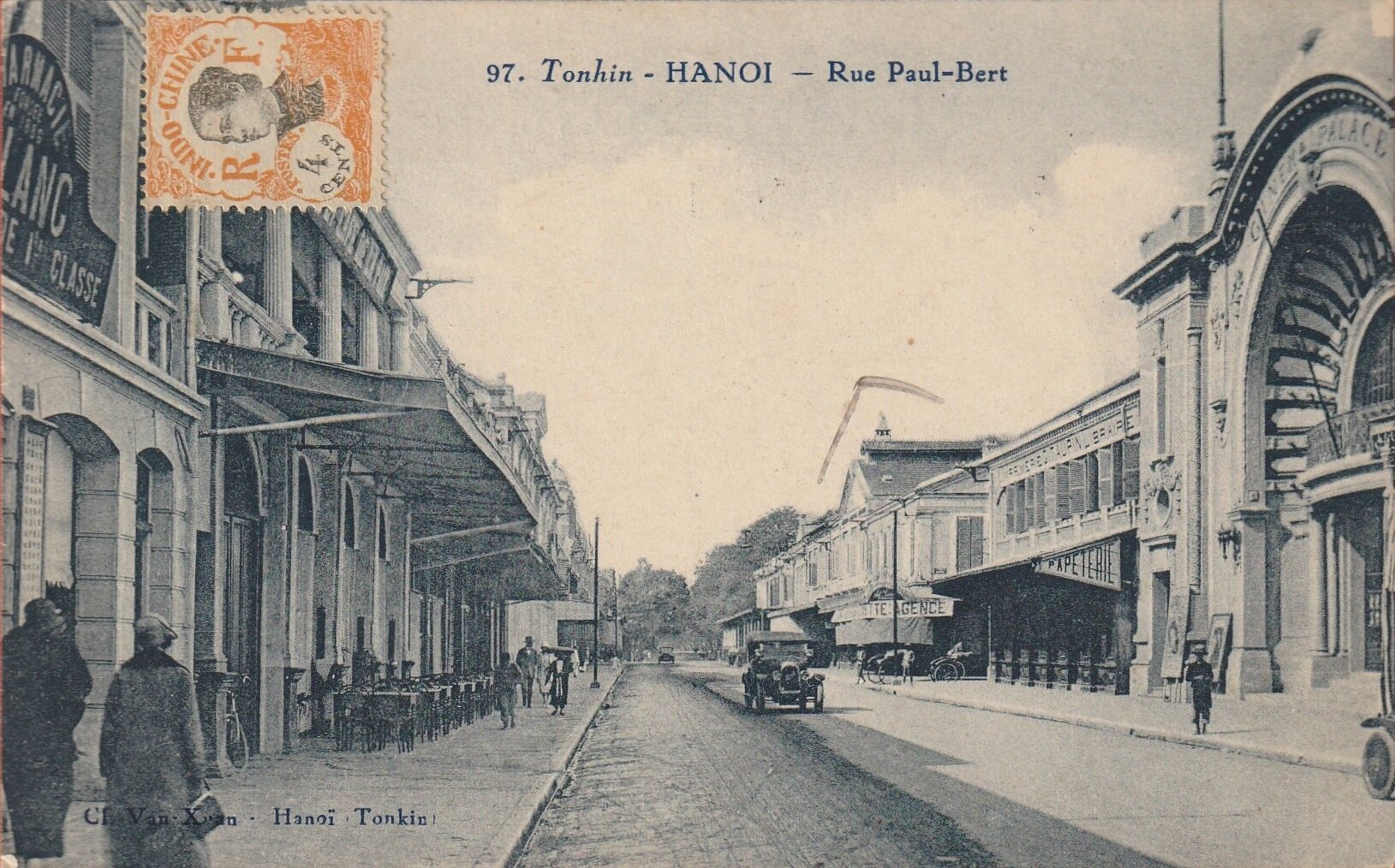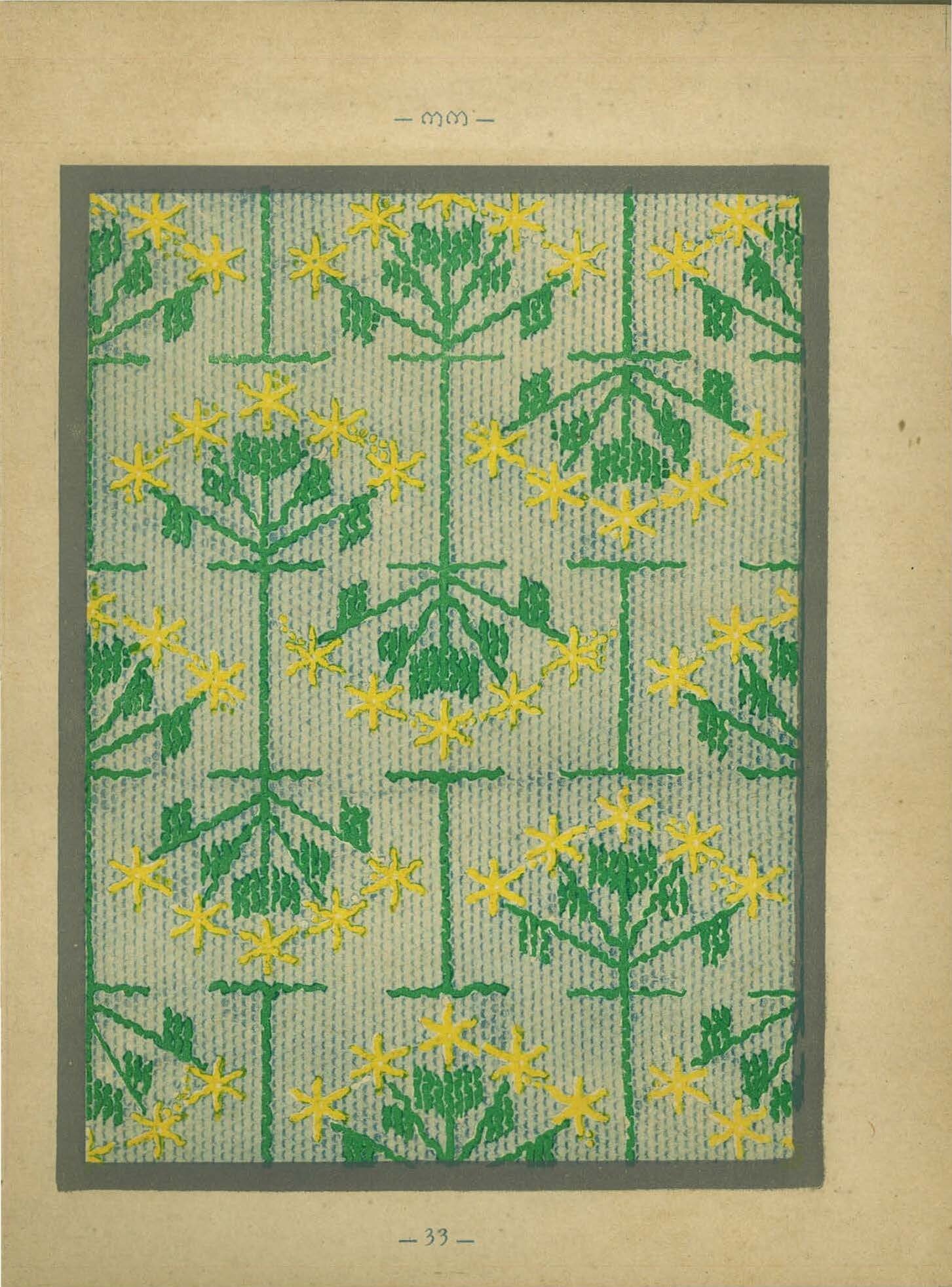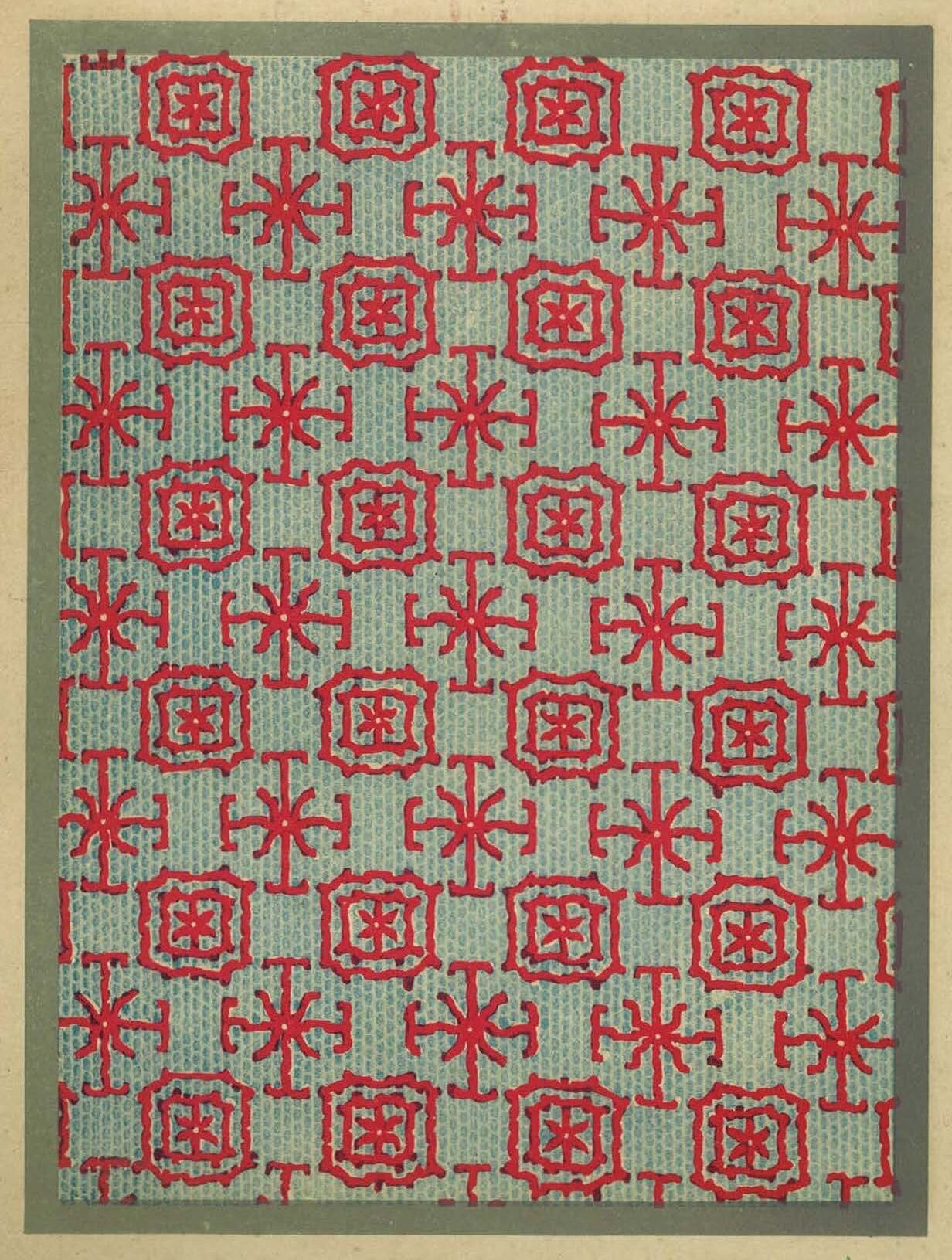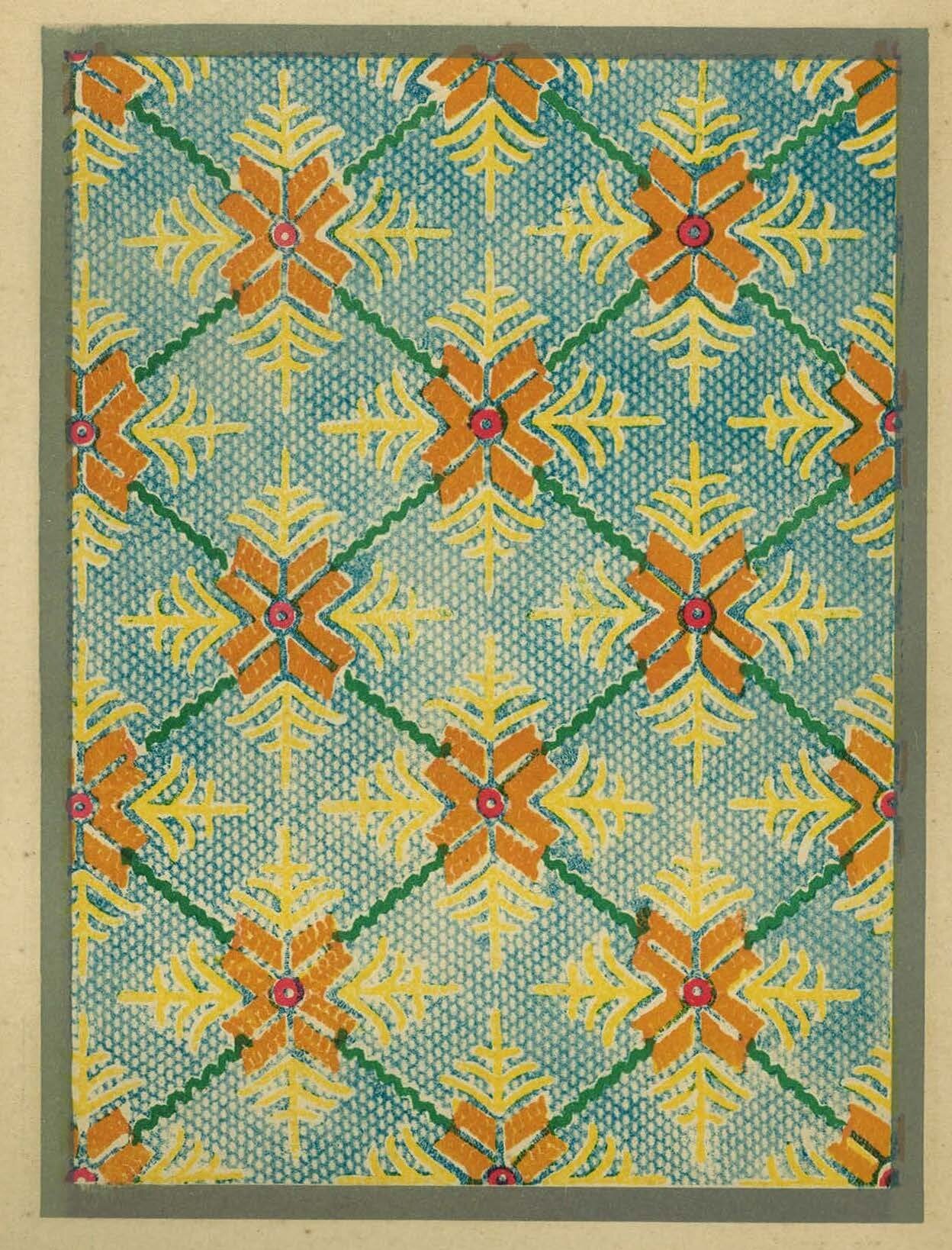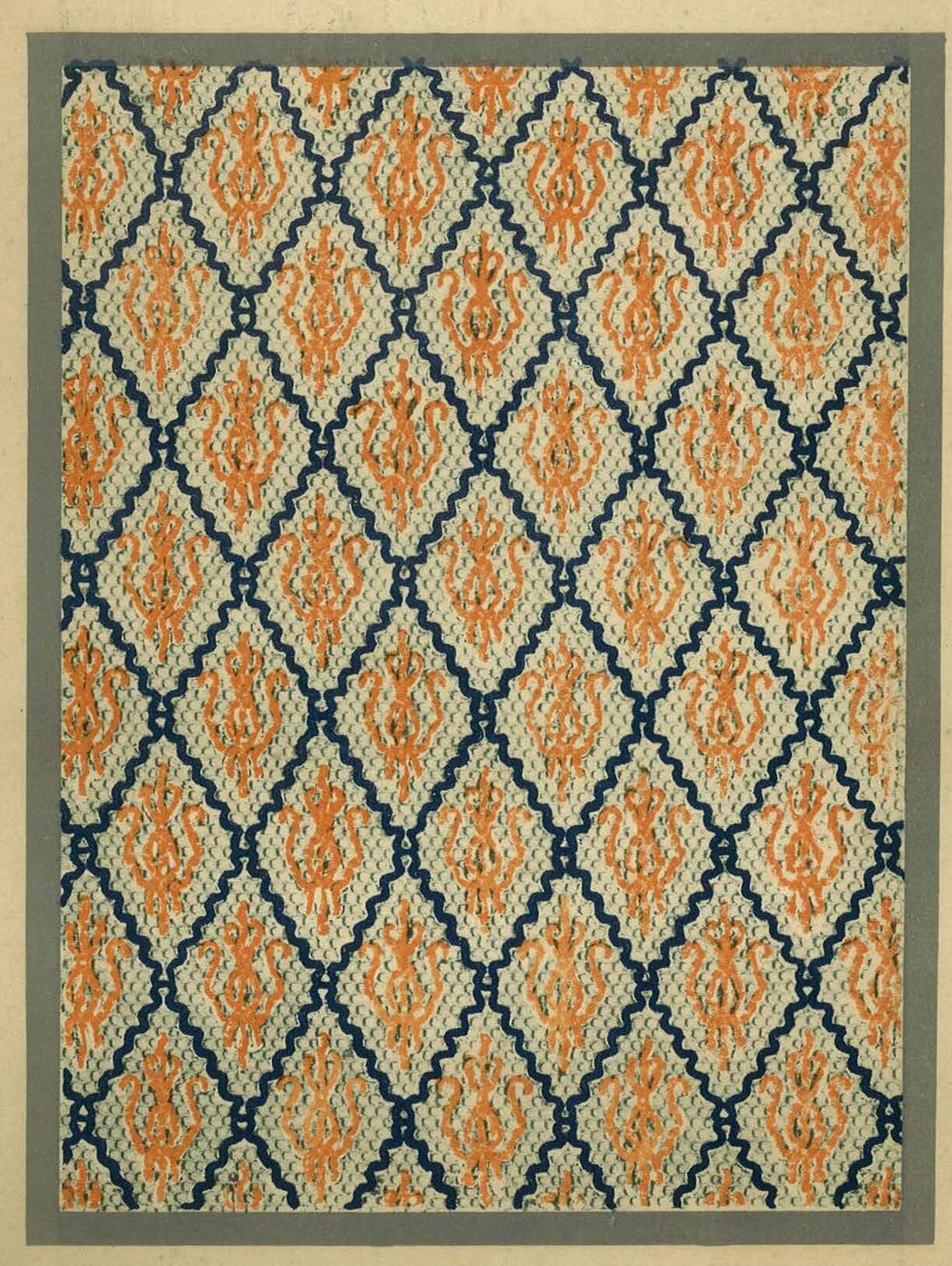គំរូក្បាច់ខ្មែរ សម្រាប់ប្រើក្នុងការប៉ាក់របស់ ព្រះអង្គម្ចាស់ក្សត្រី | Motifs decoratifs khmers a l'usage de la broderie [Khmer Embroidery Patterns]
by Rasmi Sobbhana Norodom
A unique document on Cambodian decorative patterns and embroidery style from the 1930s, listing kbach elements inherited from ancient traditions.
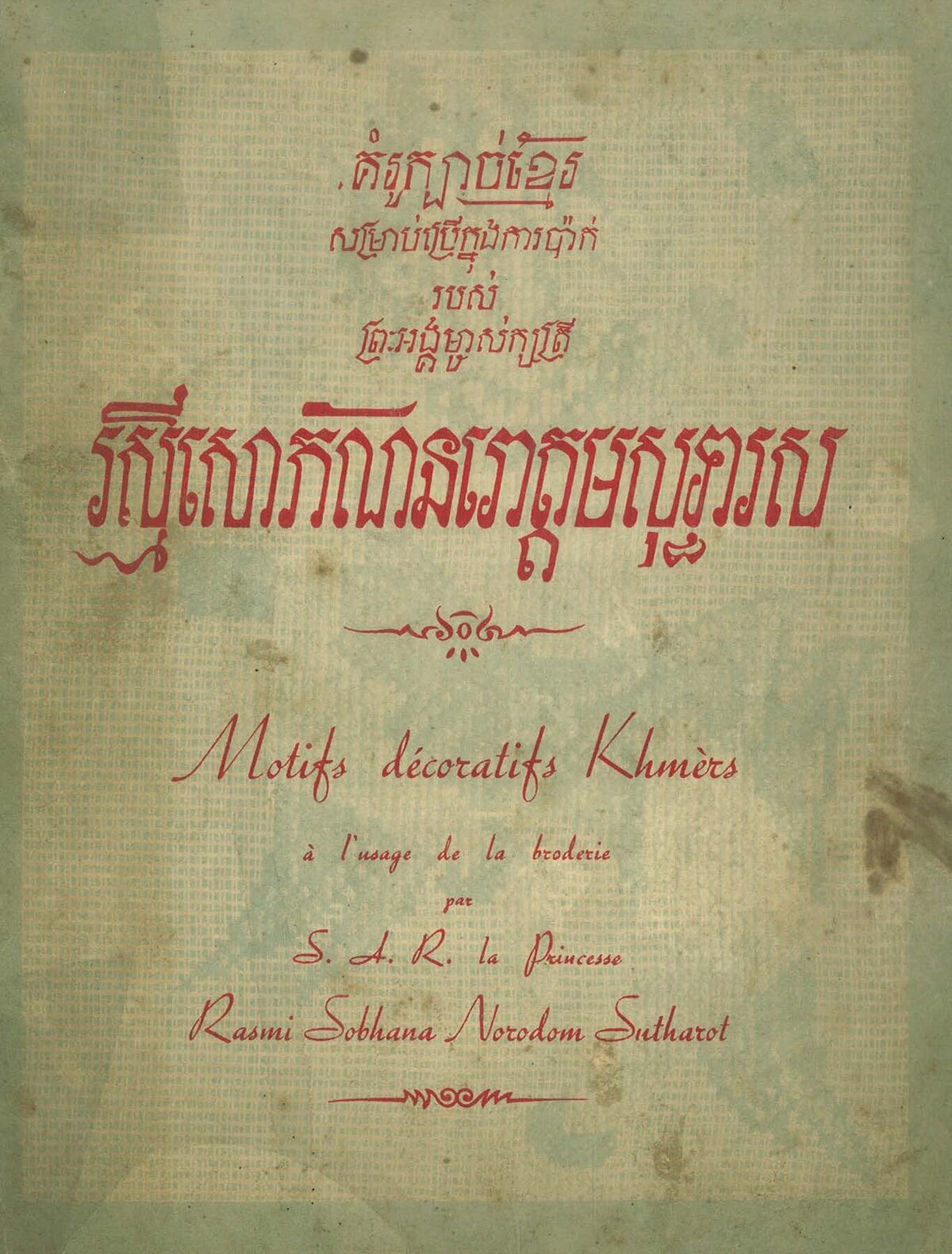
Type: on-demand books
Publisher: Buddhist Institute, Phnom Penh | undated
Edition: digitzed by Angkor Database: 2023
Published: 1935
Author: Rasmi Sobbhana Norodom
Pages: 71
Languages : French, Khmer
ADB Library Catalog ID: eKBACHPRS
Full title: គំរូក្បាច់ខ្មែរ សម្រាប់ប្រើក្នុងការប៉ាក់របស់ ព្រះអង្គម្ចាស់ក្សត្រី រស្មីសោក័ណនរោត្តមសុទ្ធារស | Motifs décoratifs khmèrs à l´usage de la broderie par la S.A.R Princesse Rasmi Sobhana Norodom Sutharot [Khmer Decorative Motifs for Embroidery, by HRH Princess Rasmi Sobhana Norodom Sutharot]
This beautifully-illustrated collection of some 66 kbach ក្បាច់ patterns/motifs deals with the timeless decoration of Ancient Khmer temples applied to embroidery (cross-stitch and on light fabric), identified and listed by Princess Norodom Rasmi Sobbhana (1898−1971), King Sihanouk’s aunt and then a teacher at Sutharot School, the first girls primary and secondary school in Cambodia.
While the book is undated, we can assume that it was printed by Taupin Printers [1] around 1935. Actually, the foreword is signed ‘S.K.’, obviously for Suzanne Karpelès, who had founded the Institut Bouddhique (Buddhist Institute) in Phnom Penh in 1930, and who edited more than 100 books and monographs on Cambodian religion and culture between 1930 and 1936. Also note that the Princess signed the book adding both her paternal grand-father’s name, Norodom [Norodom I] and her father’s name, Sutharot.
This work shows Princess Rasmi Sobbhana’s long-lasting interest for folk culture with Angkorean references, as the vast majority of these motifs were inspired by Angkor decoration. Interestingly, the first motif on her list refers to an apsara, celestial dancers, and the second to the sandalwood flower, pka chhan ផ្កាចន្ទ័, which is the most used decorative motif in Angkorean architecture. Noting that this flower is “the most used motif in Angkor bas-reliefs”, Khmerologist Francois Bizot remarked: “Les figures correspondant au décor architectural angkorien, même si elles s’appliquent à de tout autres surfaces, sont souvent désignées en cambodgien par kpâc kralâ sambal, ornement en réseau pour tissus.” [“The motifs corresponding to Angkorian architectural decoration, even if they apply to other surfaces, are often designated in Cambodian language by kbâch kralâ sambal, criss-crossed ornament for fabrics.] [F. Bizot, ‘Les ensembles ornementaux illimités d’Angkor’, Arts asiatiques, tome 21, 1970. pp. 109 – 150]
While demonstrating the richness of Cambodian flora and its impact on folk culture, this recension remains a great source of inspiration for modern-day designers. In the 1950s, when the first attempt to create a Khmer royal dance form in phase with modern times was explored by teachers and students of the Sutharot School, leading to what has been called since ‘Apsara Dance’, Princess Rasmi Sobbhana brought her expertise not only to the choreography but also to costume design [2]. Another example of how, in Cambodia, all art forms are intertwined and inspire one each other.
The last motif in the list, Plate 39, is often seen on Royal Ballet dancers’ outfits and on bas-reliefs. The name given to it by the Princess in Khmer is ក្បាច់ផ្លែពោះអំបែង, kbach phle pohambeng, literally “embellishment” in modern Khmer. In French, she noted ‘Pois de coeur’, which is probably the Cardiospermum halicacabum, known as balloon vine, heart seed, or love in a puff, a plant common in Cambodia, held as sacred medicinal plant in Kerala.
[1] Founded by Georges Taupin after Ernest Crébessac and set 50 rue Paul Bert, Hanoi, the ‘librairie-papeterie-imprimerie Taupin’ ceased its activities after the latter’s death in Nice (France) in 1945, the last book printed there in 1944 being Émile Tavernier’s Introduction à la Synthèse universelle du docteur Me Émile Gillard.
Paul Bert Street in the 1920s, with Taupin Print House on the right side. Coll. Olivier Galand.
[2] Princess Rasmi Sobbhana was a skilled embroiderer herself, and Princess Norodom Marie, in a conversation in November 2023, recalled for us that she used to sell embroidered pieces of fabric during charity events in the 1960s for the Red Cross — she was also the President of the Red Cross Cambodian chapter.
We’re reproducing below the Khmer text from the book (proof-read and adapted to modern type fonts by graphic designer Tieng Satya), the French one and our translation, as well as some of the 55 plates.
KH
សេចក្តីផ្តើម
កាលពីនាំមុនៗមកនោះ មានសៀវភៅបោះពុម្ភបែបក្បាច់រចនានៅប្រាសាទអង្គរយ៉ាងសំបើម សុទ្ធតែជាឃ្លាំងនៃគ្រឿងរចនាមានបែបផែនរបស់ខ្មែរ ឯពួកល្ខោនព្រះរាជទ្រព្យក៏នៅតែនិយមលេងល្ខោនតាមទំនៀមទម្លាប់ សឹងសំដែងឱ្យឃើញថា វិជ្ជារបាំជាន់ដើមនៅមានជីវិតរស់នៅជានិច្ច ទាំងសាលារចនាសោតទៀត ក៏បានប្រមូលនឹងបង្កើតគ្រឿងរចនាខ្នាតតូចៗរបស់ស្រុកមកដំកល់ទុកឱ្យប្រជាជនមើល ។
សព្វថ្ងៃនេះ មានព្រះអង្គម្ចាស់ក្សត្រីមួយអង្គ ទើបនឹងចាត់ការផ្សាយវិជ្ជារចនាក្នុងប្រទេសរបស់ទ្រង់ដែលទ្រង់ចេះដឹង ដោយទ្រង់ខំព្យាយាមធ្វើយ៉ាងផ្ចិតផ្ចង់ សុទ្ធតែជាក្បាច់ប៉ាក់យ៉ាងល្អៗ ។ ឯក្បាច់បាក់អស់នេះ បានរៀបចំធ្វើតាមក្បាច់ចម្លាក់ដែលមាននៅប្រាសាទអង្គរក៏មា តាមគំនូវសំពត់សារប័បនឹងល្បើកក៏មាន ។
ដោយអំណាចវិជ្ជារចនាទំនើបថ្មី នៃប្រទេសអឺរុបផ្សាយចូលមកពាសពេញ នៅស្រុកខ្មែរនេះ ទើបធ្វើឱ្យក្បាច់បាក់របស់ប្រជាជនខ្មែរកាន់តែសាបរលាបអស់ទៅ ។ ការដែលព្រះអង្គម្ចាស់ក្សត្រីរស្មីសោភ័ណសើរើការនេះឡើង ដោយទ្រង់សព្វព្រះហឫទ័យនឹងក្បាច់ប៉ាក់ក្នុងប្រទេសរបស់ទ្រង់នេះ ទុកជាការងារដ៏ប្រសើរមួយ សមជាព្រះរាជបុត្រីនៃព្រះមហាក្សត្រ ១ អង្គក្នុងសម័យដែលក្រុងកម្ពុជាផ្ដើមស្វែងរកចំណេះចេះដឹង ។
ព្រះអង្គម្ចាស់ក្សត្រីរស្មីសោភ័ណនេះហើយ ដែលទ្រង់ធ្វើការងារនេះឱ្យមានតម្លៃឡើង
ដោយឡែកមួយ ដោយទ្រង់បានកត់ត្រាឈ្មោះក្បាច់អស់នេះយ៉ាងសមរម្យ – សុទ្ធតែជាពាក្យពីរោះៗ – មានឈ្មោះគ្រប់ៗក្បាច់អស់នោះ ។
យើងជឿថា ពួកជាងរចនាគង់នឹងចាប់កូនសៀវភៅនះ មើលដោយសេចក្ដីពេញចិត្តព្រមទាំងអ្នកមានចិត្តជ្រះថ្លានឹងបែបរចនាសាមញ្ញធម្មតានេះ ក៏មានសេចក្តីគាប់ចិត្តដែរ នឹងជឿថា កូនសៀវភៅនេះនឹងទៅជាប្រដាប់សម្រាប់គូដៃនៃពួកជាងអស់នោះ នឹងនាំឱ្យពួកជាងរចនាមួយពួកមានគំនិតគិតបង្កើតក្បាច់បែបថ្មីៗឡើងទៀតបានផង ជាគ្រឿងប្រៀបធៀបរបស់អ្នកសិក្សាការរចនាផ្សេងៗបានទៀតផង យើងមានសេចក្តីទុកចិត្តថា កូនសៀវភៅនេះសុទ្ធតែជាបែបរចនាល្អៗដែលមាននៅក្នុងជំនុំជនសព្វថ្ងៃនេះ ។
ស. ក.
គំរូក្បាច់ប៉ាក់ សម្រាប់ចាក់ជាក្រឡា
លេខ ១ — ក្បាច់ទេពរបំា តាមបែបចម្លាក់អង្គរ ។
លេខ ២ — ក្បាច់ផ្កាចន្ទន៍ តាមបែបចម្លាក់អង្គរ ។
លេខ ៣ — ក្បាច់រាយផ្កាយ តាមបែបចម្លាក់អង្គរ ។
លេខ ៤ — ក្បាច់ភ្ញីវល្លិ តាមបែបចម្លាក់អង្គរ ។
លេខ ៥ — ក្បាច់គោមផ្កាចន្ទន៍ តាមបែបតម្បាញ ។
លេខ ៦ — ក្បាច់ត្របកឈូក តាមបែបចម្លាក់អង្គរ ។
លេខ ៧ — ក្បាច់កូននាគ តាមបែបតម្បាញ ។
លេខ ៨ — ក្បាច់ក្រចាប់ តាមបែបតម្បាញ ។
លេខ ៩ — គំរូក្បាច់ ក) ក្បាច់ផ្ការកា
ខ) ក្បាច់ផ្កាដង្ហិគ
គ) ក្បាច់ផ្ការាំង
ឃ) ក្បាច់ផ្ការពៅ
ង) ក្បាច់ផ្កាអង្គុញ
ច) ក្បាច់ផ្ការទន្សៃ តាមបែបតម្បាញ ។
លេខ ១០ — គំរូក្បាច់ ក) ក្បាច់ផ្កាម្រេច
ខ) ក្បាច់ហូតែង
គ) ក្បាច់ហួតែងក្លាយ តាមបែបតម្បាញ ។
លេខ ១១ — គំរូក្បាច់ ក) ផ្កាមន
ខ) ផ្កាក្ទម្ព
គ) ផ្កាព្រឹក តាមបែបតម្បាញ ។
លេខ ១២ — ក្បាច់នីលព័ទ្ធ តាមបែបរូបគំនូរជញ្ជាំងវិហារ ។
លេខ ១៣ — ក្បាច់រាជសីហ៍ តាមបែបចម្លាក់ខ្មែរ ។
លេខ ១៤ — ក្បាច់ភ្ញីវល្លិក្លាយ តាមបែបចម្លាក់អង្គរ ។
លេខ ១៥ — ក្បាច់ផ្កាទាល់ តាមបែបចម្លាក់អង្គរ ។
លេខ ១៦ — ក្បាច់ផ្កាប្រមោយដំរី តាមបែបតម្បាញ ។
តំរូក្បាច់ប៉ាក់ សម្រាប់បាក់លើសំពត់
លេខ ១ — ក្បាច់ផ្កាផ្កុលកញ្ចុំ តាមបែបចម្លាក់អង្គរ ។
លេខ ២ — ក្បាច់ផ្កាក្រូច តាមបែបតម្បាញ ។
លេខ ៣ — ក្បាច់ក្រឡាកញ្ចក់ តាមបែបតម្បាញ ។
លេខ ៤ — ក្បាច់ផ្កាកប្បាស តាមបែបតម្បាញ ។
លេខ ៥ — ក្បាច់ផ្កាពពេចចង្វា តាមបែបតម្បាញ ។
លេខ ៦ — ក្បាច់ផ្កាមង្ឈុត តាមបែបតម្បាញ ។
លេខ ៧ — ក្បាច់ផ្កាកល្បព្រឹក្ស តាមបែបតម្បាញ ។
លេខ ៨ — ក្បាច់ផ្ការ័ក តាមបែបចម្លាក់អង្គរ ។
លេខ ៩ — ក្បាច់ផ្កាម្លិះ តាមបែបតម្បាញ ។
លេខ ១០ — ក្បាច់ផ្កាបារិច្ឆត្តកព្រឹក្ស តាមបែបតម្បាញ ។
លេខ ១១ — ក្បាច់ផ្កាម្លិះផ្កុល តាមបែបតម្បាញ ។
លេខ ១២ — ក្បាច់ក្នក តាមបែបតម្បាញ ។
លេខ ១៣ — ក្បាច់សារពើសូត្រ តាមបែបតម្បាញ ។
លេខ ១៤ — ក្បាច់ប្រចាំយាម តាមបែបតម្បាញ ។
លេខ ១៥ — ក្បាច់មហាហង្ស តាមបែបតម្បាញ ។
លេខ ១៦ — ក្បាច់ផ្កាម្រេច តាមបែបតម្បាញ ។
លេខ ១៧ — ក្បាច់មណីពន្ធ តាមបែបតម្បាញ ។
លេខ ១៨ — ក្បាច់ផ្កាមាលតី តាមបែបចម្លាក់ខ្មែរ ។
លេខ ១៩ — ក្បាច់ផ្កាកណ្តៀង តាមបែបតម្បាញ ។
លេខ ២០ — ក្បាច់គ្រីបក្ងោក តាមបែបតម្បាញ ។
លេខ ២១ — ក្បាច់កូននាគ តាមបែបតម្បាញ ។
លេខ ២២ — ក្បាច់ផ្កាកក់ តាមបែបតម្បាញ ។
លេខ ២៣ — ក្បាច់ភុតតាន តាមបែបតម្បាញ ។
លេខ ២៤ — ក្បាច់ផ្កាក្រចាប់ តាមបែបតម្បាញ ។
លេខ ២៥ — ក្បាច់ទងភ្ញី តាមបែបចម្លាក់ខ្មែរ ។
លេខ ២៦ — ក្បាច់គោមផ្កាចន្ទន៍ តាមបែបតម្បាញ ។
លេខ ២៧ — ក្បាច់ភ្ញីទៀន តាមបែបចម្លាក់ខ្មែរ ។
លេខ ២៨ — ក្បាច់ភ្ញីវល្លិទេស តាមបែបចម្លាក់ខ្មែរ ។
លេខ ២៩ — ក្បាច់ផ្កាសារ៉ាយ តាមបែបតម្បាញ ។
លេខ ៣០ — ក្បាច់ក្រឡាផ្កាម្លិះ តាមបែបតម្បាញ ។
លេខ ៣១ — ក្បាច់ផ្កាម្ទេស តាមបែបតម្បាញ ។
លេខ ៣២ — ក្បាច់ផ្កាមាលតីក្លាយ តាមបែបចម្លាក់ខ្មែរ ។
លេខ ៣៣ — ក្បាច់ផ្ការោយ តាមបែបតម្បាញ ។
លេខ ៣៤ — ក្បាច់រលកទឹក តាមបែបតម្បាញ ។
លេខ ៣៥ — ក្បាច់ផ្កាននោង តាមបែបតម្បាញ ។
លេខ ៣៦ — ក្បាច់ភ្ញីវល្លិក្កាយ តាមបែបចម្លាក់ខ្មែរ ។
លេខ ៣៧ — ក្បាច់ផ្កាសារ៉ាយ (ប៉ាក់គ្រឹបលើសំពត់) តាមបែបចម្លាក់ខ្មែរ ។
លេខ ៣៨ — ក្បាច់ភ្នែកមាន់ តាមបែបចម្លាក់ខ្មែរ ។
លេខ ៣៩ — ក្បាច់ផ្លែពោះអំបែង (ប៉ាក់គ្រឹបលើសំពត់) តាមបែបចម្លាក់ខ្មែរ ។
FR
Avertissment
Depuis quelques années, de magnifiques publications sur les sculptures d’Angkor ont révélé au grand public les trésors de l’Art classique khmèr, tandis que les danseuses royales continuent à exprimer
les traditions, toujours vivantes, de l’art chorégraphique au Cambodge et que l’Ecole des Arts de Phnom-penh a fait renaître tous les arts mineurs de ce royaume. Aujourd’hui, une princesse cambodgienne vient, elle aussi, apporter sa contribution à la connaissance de l’art de son pays. Elle s’est donné la peine, non pas de copier, mais de transcrire fidèlement, pour la broderie, des motifs décoratifs, les uns plus intéressants que les autres, afin de permettre leur vulgarisation. Tous ces motifs ont été relevés, soit sur les sculptures des monuments d’Angkor, soit sur les sampots chatoyants que tissent les Cambodgiennes.
Sous la vague de modernisation européenne qui déferle sur le Cambodge comme partout en Extrême-Orient, ces trésors, qui sont aussi ceux de l’art populaire khmèr, risquaient de se perdre; la Princesse RASMI SOBHANA, en groupant ces documents, a fait un travail qui témoigne de son amour pour les arts de son pays et une oeuvre digne de la petite-fille d’un Grand Roi, sous l’impulsion de
qui Ie Cambodge commença à évoluer.
Ce qui donne une valeur toute spéciale à ce travail, c’est que la Princesse RASMI SOBHANA a pris le soin de noter le nom, très évocateur, que la tradition populaire — pleine de poésie — a donné
à chaque motif décoratif.
Nous sommes persuadés que les artistes accueilleront avec joie cette publication ainsi que tous les fervents admirateurs d’art populaire, et que ce petit livre deviendra, pour eux, un instrument de travail fort utile; les uns y puiseront des suggestions pour des motifs décoratifs nouveaux; les autres, amateurs d’études comparatives, constateront une fois de plus, nous en sommes convaincus, la filiation artistique qui existe entre tous les peuples.
S.K.
I Motifs décoratifs pour broderies au point de croix
1. — Danseuse céleste connue sous le nom d’Apsara. (Origine : sculptures khmères).
2. — Motif décoratif dit Fleurs de santal. (Origine : sculptures khmères) .
3. — Motif décoratif dit Rosace de plafond. (Origine : sculptures khmères).
4. — Motif décoratif dit Feuille de liane. (Origine : sculptures khmères).
5. — Motif décoratif dit Lampions en fleurs de santal. (Origine : tissage).
6. — Motif décoratif dit Pétales de fleurs de lotus. (Origine : sculptures khmères).
7. — Motif décoratif dit Jeune cobra. (Origine : tissage).
8. — Motif décoratif dit Noyau de chataigne d’eau. (Origine : tissage).
9. — Motifs décoratifs dits :
a) Fleurs de fromager ;
b) Fleurs de Cassier ;
c) Fleurs· de barringtonie ;
d) Fleurs de potiron ;
e) Fleurs de cajeputier ;
f) Fleurs de caryote.
(Origine : tissage).
10. — Motifs décoratifs dits :
a) Fleurs de poivrier ;
b) Pomme épineuse;
c) Fleurs de sterculie.
(Origine : tissage).
11. — Motifs décoratifs dits :
a) Fleurs de murier ;
b) Fleurs de l’arbre céleste ;
c) Etoile du matin.
(Origine : tissage).
12. Personnage simiesque du théâtre cambodgien connu sous le nom de Nilabaddha, un des héros de l’épopée indo-khmère, le “Réamker” (Ràmàyana). (Origine : Fresques de pagode).
13. Animal : lion khmèr connu sous le nom de Ràjasiha. (Origine : sculptures khmères) .
14. Motif décoratif dit Liane en fleur. (Origine : sculptures khmères).
15. Motif décoratif dit Amorphophallet de rivière. (Origine : sculptures khmères}
16. Motif décoratif dit Martynia à trompe. (Origine : tissage).
II Motifs décoratifs pour broderies sur tulle
1. — Motif décoratif dit Fleurs de câprier. (Origine : sculptures khmères).
2. — Motif décoratif dit Fleurs d’oranger. (Origine : tissage).
3. — Motif décoratif dit Facettes de miroir. (Origine : tissage).
4. — Motif décoratif dit Fleurs de cotonnier. (Origine : tissage).
5. — Motif décoratif dit Fleurs de garcinie. (Origine : tissage).
6. — Motif décoratif dit Fleurs de mangoustan. (Origine : tissage).
7. — Motif décoratif dit Fleurs de l’arbre céleste. (Origine : tissage).
8. — Motif décoratif dit Fleurs de la Passion. (Origine : sculptures khmères).
9. — Motif décoratif dit Fleurs de jasmin. (Origine : tissage).
10. — Motif décoratif dit Rose trémière. (Origine : tissage).
11. — Motif décoratif dit Fleurs de tubéreuse. (Origine : tissage}.
12. — Motif décoratif dit Fleurs de papilionacée. (Origine : tissage}.
13. — Motif décoratif dit Fleurs d’ombelle. (Origine : tissage).
14. — Motif décoratif dit En carreaux. (Origine : tissage).
15. — Motif décoratif dit Le Grand cygne mythique connu sous le nom de (Mahà Hansa). (Origine : tissage).
16. — Motif décoratif dit Fleurs de poivrier. (Origine : tissage).
17. — Motif décoratif dit Tiare en pierres précieuses. (Origine : tissage).
18. — Motif décoratif dit Fleurs d’hibiscus. (Origine : sculptures khmères).
19. — Motif décoratif dit Fleurs de sagittaire. (Origine : tissage).
20. — Motif décoratif dit Fleurs grimpantes de nauclée. (Origine : tissage).
21. — Motif décoratif dit Capuchon de jeune cobra. (Origine : tissage).
22. — Motif décoratif dit Fleurs de jonc. (Origine : tissage).
23. — Motif décoratif dit Ecran brodé. (Origine : tissage).
24. — Motif décoratif dit Fleurs de macre. (Origine : tissage).
25. — Motif décoratif dit Feuilles de pontédérie. (Origine : sculptures khmères).
26. — Motif décoratif dit Fleurs de cornifle. (Origine : tissage).
27. -· Motif décoratif dit Chandelier avec flamme de cierge. (Origine : sculptures khmères).
28. — Motif décoratif dit Feuilles de liane. (Origine : tissage).
29. — Motif décoratif dit Algue d’eau douce. (Origine : tissage).
30. — Motif décoratif dit Filet en pétales de jasmin. (Origine : tissage).
31 . — Motif décoratif dit Fleurs de piment. (Origine : tissage).
32. — Motif décoratif dit Fleurs de gardénia. (Origine : tissage).
33. — Motif décoratif dit Fleurs d’ombellée. (Origine : tissage).
34. — Motif décoratif dit Ondulations de l’eau. (Origine : tissage).
35. — Motif décoratif dit Courge fibreuse. (Origine : tissage).
36. — Motif décoratif dit Liane en fleurs. (Origine : sculptures khmères).
37. — Motif décoratif dit Fleurs d’algue. (Origine : tissage).
38. — Motif décoratif dit Oeil de coq. (Origine : sculptures khmères).
39. — Motif décoratif dit Pois de coeur [also Coeur des Indes in French]. (Origine : sculptures khmères).
ENG
Angkor Database translation [when needed, we have added species scientific names]:
Foreword
For several years, magnificent publications on the sculptures of Angkor have revealed to the general public the treasures of classical Khmer Art, while the royal dancers continue to express
the living traditions of choreographic art in Cambodia, and the Phnom Penh School of Arts has revived all the minor arts of this kingdom. Today, a Cambodian princess also comes forward to contribute to the knowledge of her country’s art. She took the trouble, not to copy but to faithfully transcribe for embroidery, decorative motifs, some more interesting than others, in order to allow their popularization. All these motifs have been observed, either on the sculptures of Angkor monuments, or on the shimmering sampots that Cambodian women weave.
Under the wave of European modernization which is sweeping Cambodia as everywhere else in the Far East, these treasures, which are also those of Khmer folk art, were at risk of being lost; Princess RASMI SOBHANA, by grouping these documents, has done a work which testifies to her love for the arts of her country, an endeavor worthy of the granddaughter of a Great King, under the impetus of
which Cambodia began to evolve.
What gives a very special value to this work is that Princess RASMI SOBHANA took care to note the evocative names that popular tradition — full of poetry — gave to each decorative motif.
We are convinced that artists will welcome this publication with joy as will all fervent admirers of popular art, and that this little book will become, for them, a truly useful working tool; some will draw from it suggestions for new decorative motifs; others, lovers of comparative studies, will note once again — of that we are convinced — the artistic filiation that exists between all peoples.
S.K.
I) Decorative patterns for cross stitch embroidery
1. — Celestial dancer known as Apsara. (Origin: Khmer sculptures).
2. — Decorative motif called Sandalwood Flowers. (Origin: Khmer sculptures).
3. — Decorative motif called Ceiling Rose. (Origin: Khmer sculptures).
4. — Decorative motif called Creeper Leaf. (Origin: Khmer sculptures).
5. — Decorative motif called Sandalwood-Flower-Shaped Lanterns. (Origin: weaving).
6. — Decorative motif called Lotus Flower Petals. (Origin: Khmer sculptures).
7. — Decorative motif called Young Cobra. (Origin: weaving).
8. — Decorative motif called Water Chestnut Kernel. (Origin: weaving).
9. — Decorative motifs called:
a) Ceiba (or Kapok) Flowers [Bombax ceiba];
b) Cassia Tree Flowers;
c) Barringtonia Flowers [Barringtonia acutangula];
d) Pumpkin Flowers;
e) Cajuputi Flowers [Melaleuca cajuputi];
f) Wine Palm Flowers [Caryota urens].
(Origin: weaving).
10. — Decorative motifs called:
a) Pepper Flowers;
b) Thorn Apple (Angel’s Trumpet) [Datura innoxia];
c) Sterculia Flowers [Sterculia stigmarota].
(Origin: weaving).
11. — Decorative motifs called:
a) Mulberry flowers;
b) Flowers of the Celestial Tree;
c) Morning Star.
(Origin: weaving).
12. Monkey-like character from Cambodian theater known as Nilabaddha, one of the heroes of the Indo-Khmer epic Reamker (Ràmàyana). (Origin: Pagoda frescoes).
13. Animal: Khmer lion known as Ràjasiha. (Origin: Khmer sculptures).
14. Decorative motif called Blossoming Vine. (Origin: Khmer sculptures).
15. Decorative motif called River Amorphophallus. (Origin: Khmer sculptures}
16. Decorative motif called Martynia Proboscidea. (Origin: weaving).
II) Decorative patterns for embroidery on tulle
1. — Decorative motif called Caper Flowers [Capparis spinosa]. (Origin: Khmer sculptures).
2. — Decorative motif called Orange Blossoms. (Origin: weaving).
3. — Decorative pattern called Faceted Mirror. (Origin: weaving).
4. — Decorative motif called Cotton Flowers. (Origin: weaving).
5. — Decorative motif called Malabar Tamarind [Garcinia cambogia] Flowers. (Origin: weaving).
6. — Decorative motif called Mangosteen Flowers. (Origin: weaving).
7. — Decorative motif called Flowers of the Celestial Tree. (Origin: weaving).
8. — Decorative motif called Passion Flowers. (Origin: Khmer sculptures).
9. — Decorative motif called Jasmine Flowers. (Origin: weaving).
10. — Decorative motif called Hollyhock. (Origin: weaving).
11. — Decorative motif called Tuberose Flowers. (Origin: weaving}.
12. — Decorative motif called Papilionaceae flowers. (Origin: weaving}.
13. — Decorative motif called Umbel Flowers. (Origin: weaving).
14. — Decorative pattern called Checkered. (Origin: weaving).
15. — Decorative motif called the Great Mythical Swan known as (Mahà Hansa). (Origin: weaving).
16. — Decorative motif called Pepper Blossoms. (Origin: weaving).
17. — Decorative motif called Precious Stones Tiara. (Origin: weaving).
18. — Decorative motif called Hibiscus Flowers. (Origin: Khmer sculptures).
19. — Decorative motif called Sagittarius Flowers. (Origin: weaving).
20. — Decorative motif called Nauclea Tree [Nauclea orientalis] Climbing Flowers. (Origin: weaving).
21. — Decorative motif called Young Cobra Hood. (Origin: weaving).
22. — Decorative motif called Bulrush Flowers. (Origin: weaving).
23. — Decorative motif called Embroidered Screen. (Origin: weaving).
24. — Decorative motif called Water Chestnut [Trapa natans] Flowers. (Origin: weaving).
25. — Decorative motif called Water Hyacinth [Pontederia crassipes] Leaves. (Origin: Khmer sculptures).
26. — Decorative motif called Coontail [Ceratophyllum demersum] Flowers. (Origin: weaving).
27. -· Decorative motif called Candlestick with Candle Flame. (Origin: Khmer sculptures).
28. — Decorative motif called Vine Leaves. (Origin: weaving).
29. — Decorative motif called Freshwater Algae. (Origin: weaving).
30. — Decorative motif called Jasmine Petal Net. (Origin: weaving).
31. — Decorative motif called Chili Flowers. (Origin: weaving).
32. — Decorative motif called Gardenia Flowers. (Origin: weaving).
33. — Decorative motif called Umbelliferae Flowers. (Origin: weaving).
34. — Decorative motif called Water Ripples. (Origin: weaving).
35. — Decorative motif called Luffa Gourd. (Origin: weaving).
36. — Decorative motif called Blossoming Vine. (Origin: Khmer sculptures).
37. — Decorative motif called Seaweed Flowers. (Origin: weaving).
38. — Decorative motif called Rooster’s Eye. (Origin: Khmer sculptures).
39. — Decorative motif called Balloon Vine [Cardiospermum halicacabum][?]. (Origin: Khmer sculptures).
In his study on ornementation at Angkor (1970, op. cit.), Francois Bizot shared some samples of kbach krala sambal, drawn in situ. Compare with the Kbach Catalog for embroidery collated by Princess Rasmi Sobbhana.
Tags: embroidery, Khmer arts, Royal Family of Cambodia, material culture, design, kbach, education, flora, rivers, rainforest, botanic
About the Author
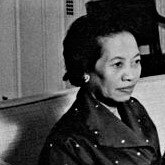
Rasmi Sobbhana Norodom
H.R.H. Princess Norodom Rasmi Sobbhana (សម្តេចព្រះរាជកនិដ្ឋា នរោត្តម រស្មីសោភ័ណ្ឌ, Samdech Preah Reach Kanitha Norodom Reaksmey Sophoan in Khmer) (Nov. 1898, Phnom Penh ‑1971, Phnom Penh), daughter of Prince Norodom Sutharot and Princess Norodom Phangangam, was the sister of King Norodom Suramarit, sister-in-law of Queen Kossamak of Cambodia and aunt of King Norodom Sihanouk.
Unmarried, she dedicated her life to social action, in particular the education and empowerment of young women in the Kingdom of Cambodia, as a teacher at Phnom Penh Sutharot School and as the author of two published books: Motifs décoratifs Khmers à l’usage de la broderie (1954) and L’Art de la cuisine cambodgienne (1960). She has been credited of being the first to create the modern ‘Apsara dance’ form in 1958.
In the 1950s and 1960s, Samdech Kanitha was actively helping King (then Prince) Norodom Sihanouk in his effort to promote his non-aligned diplomacy, as seen for instance in the photo below in the White Office Oval Office, with President John F. Kennedy in 1960. She also found a social club for the spouses of the ambassadors accredited to the Kingdom of Cambodia, and presided over the Red Cross’ Cambodian chapter.
At the White House with US President John F. Kennedy, 1960. [courtesy of JFK Library].
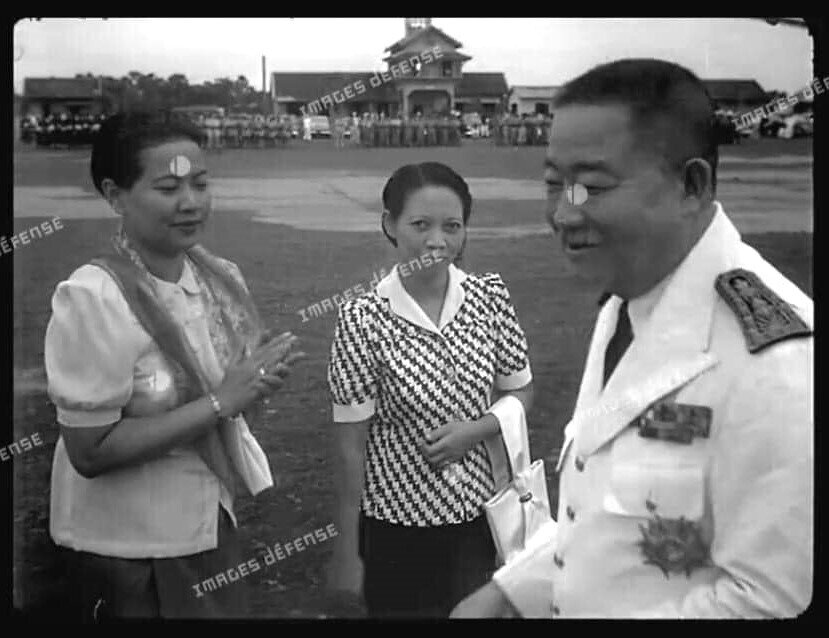
1) Princess Rasmi Sobbhana at the arrival of King Norodom Sihanouk’s royal visit in Luang Prabang, Kingdom of Laos, in 1961, with King Srey Svang Vathana, the last sovereign of the Kingdom of Laos, and his spouse [retrieved by @Neath Coffee, 9/7/2023. Unfortunate watermarks added by the French Defense Ministy Information Service hide part of her face]. 2) Attending a Visak Bochea sermon with female monks, 15 April 1957 [photo kindly shared by Srin Sokmean].
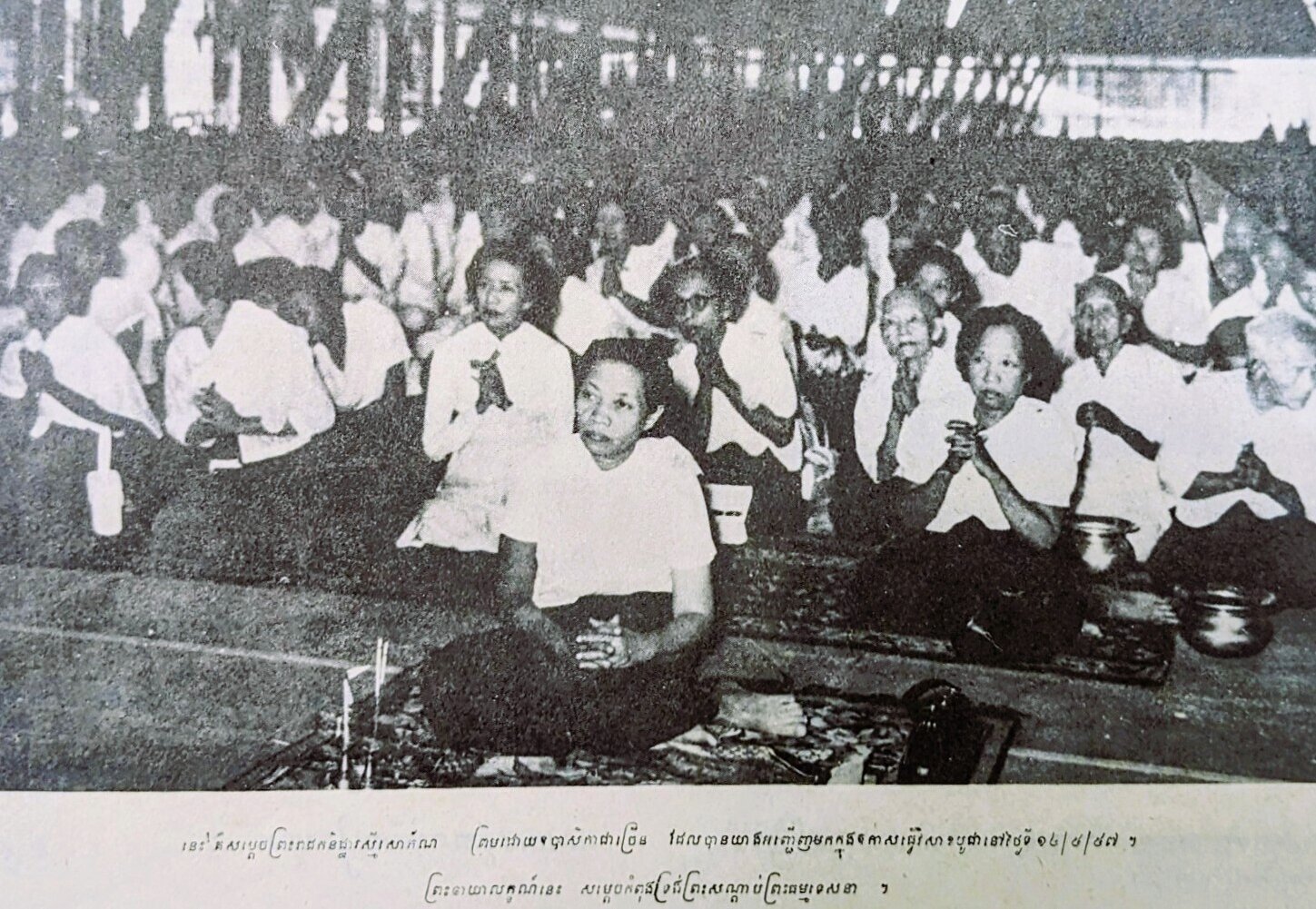
1) Princess Rasmi Sobbhana at the arrival of King Norodom Sihanouk’s royal visit in Luang Prabang, Kingdom of Laos, in 1961, with King Srey Svang Vathana, the last sovereign of the Kingdom of Laos, and his spouse [retrieved by @Neath Coffee, 9/7/2023. Unfortunate watermarks added by the French Defense Ministy Information Service hide part of her face]. 2) Attending a Visak Bochea sermon with female monks, 15 April 1957 [photo kindly shared by Srin Sokmean].
1) Princess Rasmi Sobbhana at the arrival of King Norodom Sihanouk’s royal visit in Luang Prabang, Kingdom of Laos, in 1961, with King Srey Svang Vathana, the last sovereign of the Kingdom of Laos, and his spouse [retrieved by @Neath Coffee, 9/7/2023. Unfortunate watermarks added by the French Defense Ministy Information Service hide part of her face]. 2) Attending a Visak Bochea sermon with female monks, 15 April 1957 [photo kindly shared by Srin Sokmean].
In 1995, H.R.H. Princess Norodom Ranaridh Marie created the Samdech Rasmi Sobbhana Women’s Foundation, named after S.A.R. Princess Rasmi Sobhana. Initially a shelter for war orphans and refugee children on the Thai-Cambodian border, the Sobbhana Foundation opened three training centers helping young Cambodians to master traditional craft skills such as silk weaving, embroidery or wood carving. In 2022, after the expanded republication of the Princess’ book, a Samdech Rasmi Sobbhana Scholarship Program was launched with the proceeds from the book’s sales, with the active support of Templation Angkor Resort and Angkor Database.
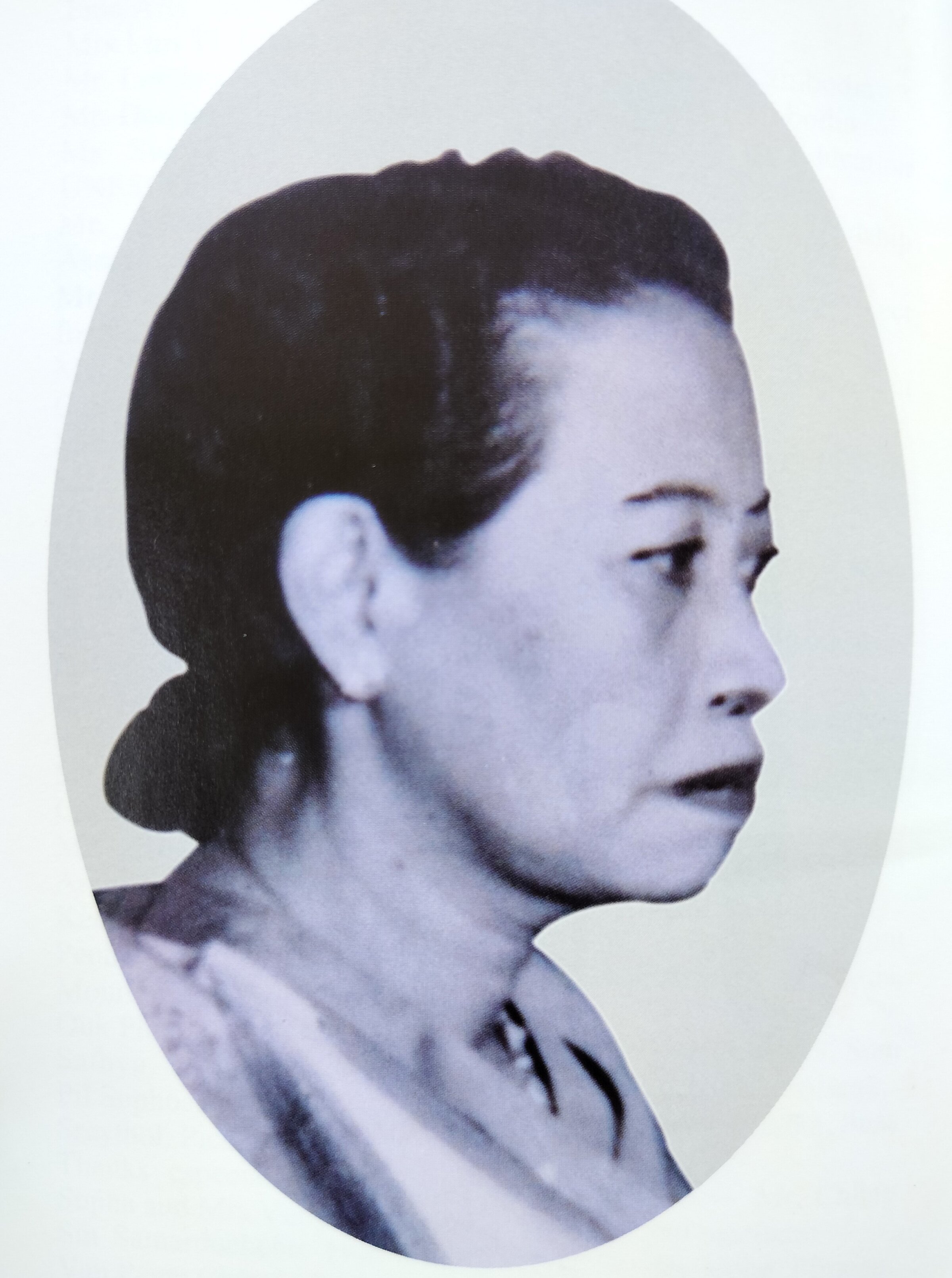
1) The Princess’ portrait in the book Apsara Dance, dedicated to Queen Kossamak and to her. 2) Another portrait of Samdech Kanitha in the 1960s. [courtesy of HRH Princess Norodom Marie.]
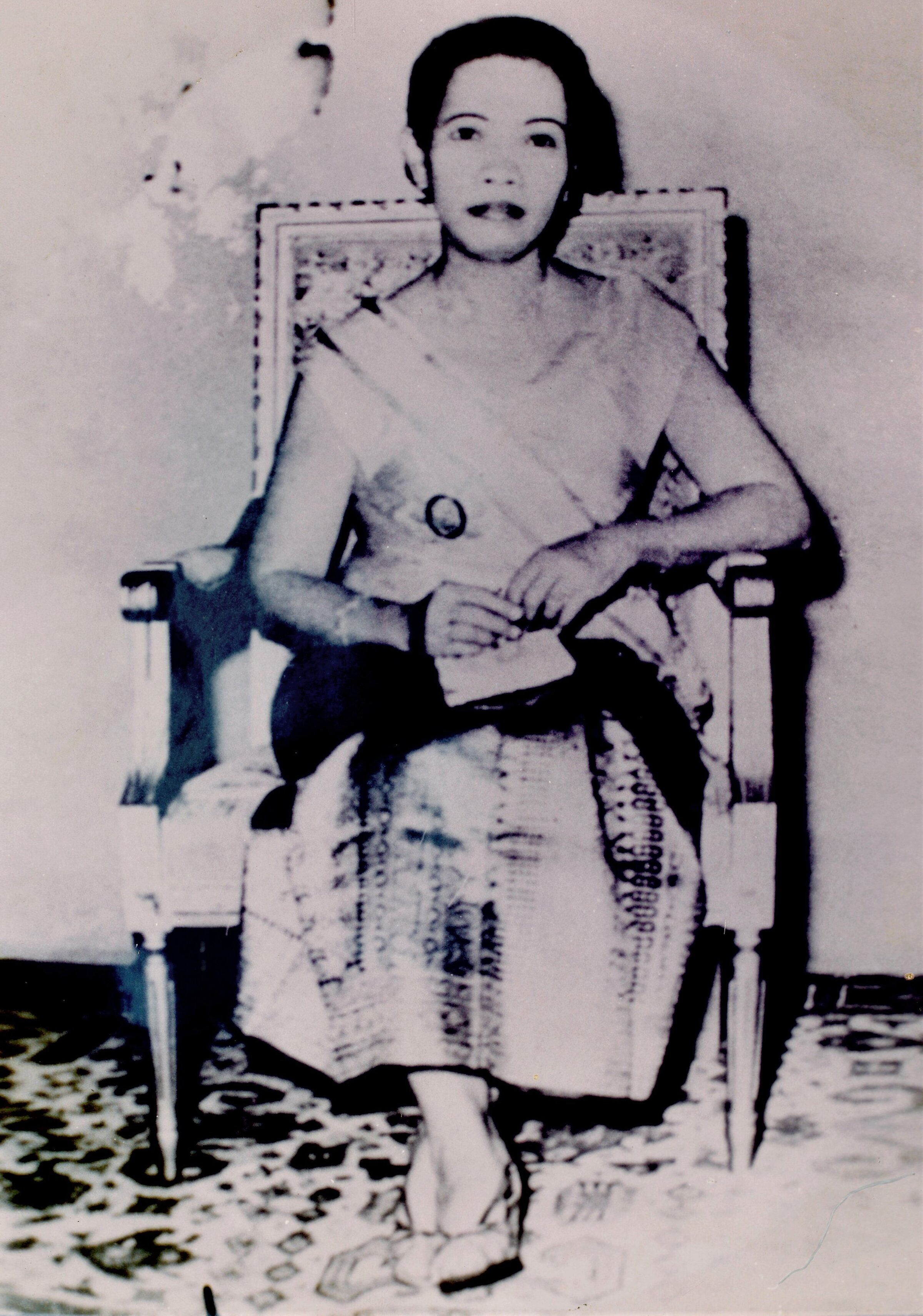
1) The Princess’ portrait in the book Apsara Dance, dedicated to Queen Kossamak and to her. 2) Another portrait of Samdech Kanitha in the 1960s. [courtesy of HRH Princess Norodom Marie.]
1) The Princess’ portrait in the book Apsara Dance, dedicated to Queen Kossamak and to her. 2) Another portrait of Samdech Kanitha in the 1960s. [courtesy of HRH Princess Norodom Marie.]


